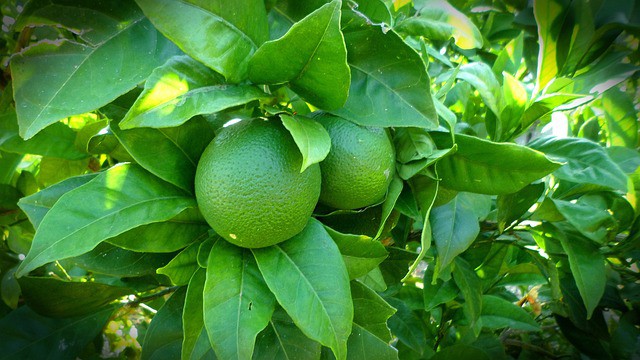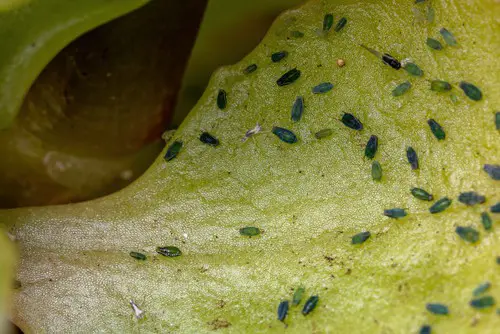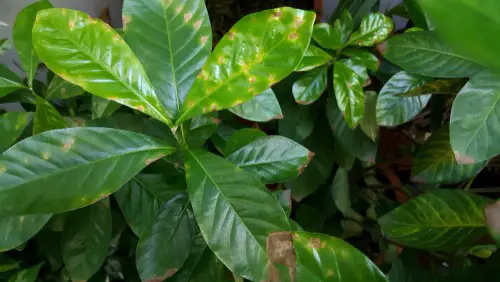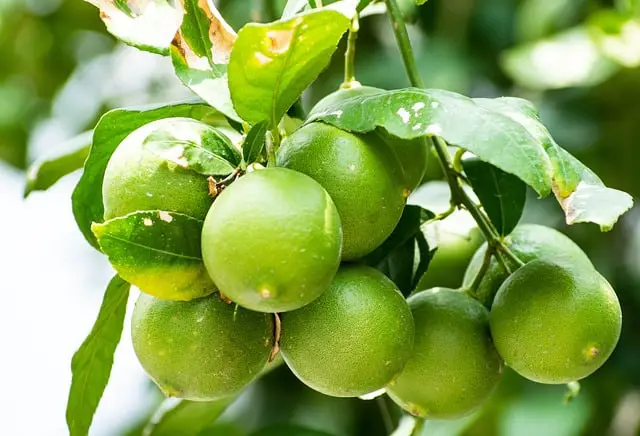Lemon trees are a popular fruit tree for many gardeners, and for good reason. They are easy to grow, produce delicious fruit, and add a lovely fragrance to any garden.
However, despite their many benefits, they are not immune to disease, and one of the most common issues that gardeners face is black spots on lemon tree leaves. These spots can be a sign of several diseases that can be quite dangerous for the tree if left untreated.
Understanding the causes and symptoms of black spots on lemon tree leaves is essential for gardeners who want to keep their trees healthy and productive. There are many factors that can contribute to the development of black spots, including fungal and bacterial infections, environmental conditions, and pests.
Identifying the specific cause of the black spots is crucial for effective treatment and prevention strategies, which can range from pruning infected branches to applying fungicides or insecticides.
Despite the potential damage that black spots can cause to lemon trees, there are many effective ways to manage and prevent this issue. Regular inspection and maintenance of the tree, as well as proper fertilization and watering, can go a long way in keeping the tree healthy and resistant to disease.
By understanding the causes and symptoms of black spots on lemon tree leaves, gardeners can take the necessary steps to ensure that their trees remain productive and healthy for years to come.
Key Takeaways
- Black spots on lemon tree leaves can be a sign of several diseases that can be dangerous if left untreated.
- Identifying the specific cause of the black spots is crucial for effective treatment and prevention strategies.
- Regular inspection, maintenance, and proper fertilization and watering can help prevent black spots and keep lemon trees healthy.
More on this category:
- Cannabis Black Spots on Leaves
- How to Treat Black Spots on Palm Leaves
- How to Treat Black Spots on Hibiscus Leaves
Understanding Black Spots on Lemon Tree Leaves

Black spots on lemon tree leaves are a common problem that can affect the health of your lemon trees. These spots can be caused by various factors, including fungal or bacterial infections, insect infestations, or environmental stress.
Understanding the underlying causes of black spots on lemon tree leaves is crucial to effectively treating and preventing them.
Causes of Black Spots on Lemon Tree Leaves
1. Fungal and Bacterial Infections
One of the most common causes of black spots on lemon tree leaves is fungal or bacterial infections. These infections can be caused by various pathogens, including citrus black spot, melanose, and greasy spot. Symptoms of these infections can include black or dark brown spots on the leaves, as well as on the fruit, stems, and twigs.
2. Insect Infestations
Insect infestations can also cause black spots on lemon tree leaves. Aphids, whiteflies, and scale insects are common pests that can feed on the leaves of lemon trees, causing damage and stress to the plant. This can lead to the development of black spots on the leaves.
3. Environmental Stress
Environmental stress can also cause black spots on lemon tree leaves. This can include exposure to extreme temperatures, drought, or poor soil conditions. When a lemon tree is stressed, it may be more susceptible to infections and infestations, which can lead to the development of black spots on the leaves.
Treatment and Prevention
To treat and prevent black spots on lemon tree leaves, it is important to identify the underlying cause of the problem. For fungal or bacterial infections, treatment may involve the use of fungicides or bactericides, as well as good cultural practices such as pruning and proper irrigation.
Insect infestations can be treated with insecticides, while environmental stress can be prevented by providing proper care and maintenance to the lemon tree.
Regular monitoring of your lemon tree for signs of black spots on the leaves can help you catch and treat the problem early, before it becomes more severe. By taking the necessary steps to prevent and treat black spots on lemon tree leaves, you can help ensure the health and productivity of your lemon trees.
Lemon Tree Leaves Black Spots – 4 Common Problems

Lemon trees are a popular addition to many gardens, prized for their fragrant blossoms and tart fruits. However, one common issue that lemon tree owners face is the appearance of black spots on the leaves.
These spots can be caused by a variety of factors, including fungal and bacterial infections, pests and diseases, and environmental factors.
1. Fungal Infections
Fungal infections are a common cause of black spots on lemon tree leaves. One type of fungus that can cause black spots is Guignardia citricarpa, which causes citrus black spot. This fungus can cause lesions on both the leaves and the fruit of the lemon tree.
Another type of fungus that can cause black spots is Alternaria alternata, which causes alternaria leaf spot. This fungus can cause lesions on the leaves of the lemon tree.
2. Bacterial Infections
Bacterial infections can also cause black spots on lemon tree leaves. One type of bacteria that can cause black spots is Xanthomonas axonopodis, which causes citrus canker. This bacteria can cause lesions on the leaves, fruit, and trunk of the lemon tree.
3. Pests and Diseases
Pests and diseases can also contribute to the appearance of black spots on lemon tree leaves. One common pest that can cause black spots is the Asian citrus psyllid, which can transmit the bacteria that causes citrus greening. This disease can cause black spots on the leaves and fruit of the lemon tree.
Another pest that can cause black spots is aphids, which secrete honeydew that can lead to the growth of sooty mold on the leaves.
4. Environmental Factors
Environmental factors can also contribute to the appearance of black spots on lemon tree leaves. Excessive rain or humidity can create conditions that are favorable for the growth of fungi and bacteria.
High temperatures can also stress the lemon tree, making it more susceptible to infection. Additionally, exposure to light can cause lesions on the leaves, a condition known as virulent spot.
Symptoms of Black Spots on Lemon Tree Leaves

Lemon trees are a beautiful addition to any garden or orchard. However, they are susceptible to various diseases and pests, including black spots on their leaves. These black spots are a sign of a fungal infection that can cause significant damage to the tree if left untreated.
Here are some of the symptoms of black spots on lemon tree leaves:
- Black Spots on Leaves: The most apparent symptom of black spots on lemon tree leaves is the presence of small black spots on the leaves. These spots can be circular or irregular in shape and can range in size from a pinhead to several millimeters in diameter.
- Leaf Drop: As the infection progresses, the leaves may start to yellow and drop from the tree. This can lead to significant leaf loss, which can impact the tree’s ability to produce fruit.
- Fruit Drop: In addition to leaf drop, the tree may also start to drop fruit prematurely. This can be a significant problem for orchard owners, as it can lead to a decrease in crop yield.
- Lesions on Leaves and Fruit: As the infection progresses, the black spots may start to form lesions on the leaves and fruit. These lesions can be sunken or raised and can be surrounded by a yellow halo.
- Stunted Growth: The fungal infection can also cause stunted growth in the tree. This can lead to a decrease in the size and quality of the fruit produced by the tree.
If you notice any of these symptoms on your lemon tree, it is essential to take action to treat the infection. There are several methods of treatment, including pruning infected branches, using fungicides, and improving the tree’s growing conditions.
It is also essential to take preventative measures, such as maintaining proper irrigation and fertilization practices, to reduce the risk of future infections.
Effects on Lemon Tree Health and Fruit Quality
Black spots on lemon tree leaves can have a significant impact on the health and quality of the fruit. The fungus responsible for citrus black spot, Guignardia citricarpa, can infect both the leaves and fruit of lemon trees, reducing both the quantity and quality of the fruit.
When the fungus infects mature fruit, it can cause the fruit to develop raised, black spots that can affect the texture and taste of the fruit. The spots can make the fruit less appealing to consumers and reduce the market value of the crop. The fruit can also become misshapen or distorted, further reducing its quality.
In addition to affecting the fruit, black spots on lemon tree leaves can also impact the health of the tree itself. The fungus can weaken the tree and make it more susceptible to other diseases and pests. Over time, this can lead to reduced productivity and lower yields.
It is important to note that black spots on lemon tree leaves do not always indicate the presence of citrus black spot. Other diseases and pests can also cause black spots on leaves and affect the health and quality of the fruit. It is important to properly identify the cause of the black spots before taking any action to treat the tree.
Diagnosing Black Spots on Lemon Tree Leaves

Black spots on lemon tree leaves can be a sign of various diseases and fungal infections. It is important to diagnose the issue accurately to prevent further damage to the tree and ensure proper treatment.
One of the most common diseases that cause black spots on lemon tree leaves is citrus black spot. This fungal disease affects all citrus varieties and can cause lesions on leaves and fruit. The disease is spread by rain, wind, and insects. It is important to manage and regulate the disease to prevent its spread.
Another fungal disease that can cause black spots on lemon tree leaves is alternaria leaf spot. This disease causes brown spots with yellow halos on leaves and can lead to defoliation. Greasy spot fungus and anthracnose are other fungal diseases that can cause black spots on lemon tree leaves.
Bacterial infections such as citrus canker and bacterial leaf scorch can also cause black spots on lemon tree leaves. Citrus canker causes raised, necrotic lesions on leaves, fruit, and twigs. Bacterial leaf scorch causes leaf scorching and black spots on leaves.
In addition to diseases and fungal infections, black spots on lemon tree leaves can also be caused by an infestation of pests such as aphids and whiteflies. These pests excrete honeydew, which can lead to the growth of sooty mold on leaves.
Diagnosing the issue accurately is crucial to determine the appropriate treatment. Fungicides, neem oil, and soap can be used to treat fungal diseases, while infected trees may need to be removed to prevent the spread of disease.
Root rot caused by overwatering can also cause black spots on lemon tree leaves and can be treated by improving drainage.
Treatment and Prevention Strategies

Black spots on lemon tree leaves are a common problem that can be addressed with various treatment and prevention strategies.
1. Chemical Treatments
Chemical treatments such as copper fungicides, bactericides, and fungicides containing iron can be effective in controlling black spots on lemon tree leaves. These chemicals work by killing the fungus causing the black spots.
However, it is important to follow the instructions carefully and avoid overuse, as this can lead to toxicity and damage to the tree.
2. Cultural Practices
Cultural practices such as proper watering, drainage, and pruning can help prevent black spots on lemon tree leaves. Gardeners should avoid overwatering and ensure proper drainage to prevent waterlogging, which can create conditions conducive to fungal growth.
Pruning infected leaves and branches can also help prevent the spread of the fungus.
3. Biological Control
Beneficial insects such as ladybugs and lacewings can help control black spots on lemon tree leaves by feeding on the fungus causing the spots.
Additionally, using neem oil or soap sprays can help control the fungus by disrupting its life cycle. These biological control methods are safe and environmentally friendly alternatives to chemical treatments.
4. Resistant Varieties
Planting resistant varieties of lemon trees can help prevent black spots on lemon tree leaves. Varieties such as Meyer lemon and Lisbon lemon are known for their resistance to black spot fungus.
Preventing black spots on lemon tree leaves requires a combination of good cultural practices, biological control, and the use of chemical treatments when necessary. By following these strategies, gardeners can ensure healthy and vibrant lemon trees that are resistant to black spot fungus.
Impact of Environmental Conditions

Lemon trees are sensitive to changes in their environment, and various environmental factors can contribute to the development of black spots on their leaves.
Some of the most significant environmental factors that can impact the health of lemon trees include water, rain, light, soil, summer, humidity, temperature, drainage, irrigation, and climate.
Water is essential for the growth and development of lemon trees, but too much or too little water can cause problems. Overwatering can lead to poor drainage and soil saturation, which can create ideal conditions for fungal growth and disease development.
On the other hand, underwatering can cause stress to the tree, making it more susceptible to disease and pests.
Rain can also impact the health of lemon trees, especially during the summer months when the weather is warm and humid. Excessive rain can cause soil erosion and flooding, which can damage the root system and lead to poor growth and development.
Additionally, rain can create ideal conditions for fungal growth and disease development, especially if the tree is already stressed or weakened.
Light is another critical factor that can impact the health of lemon trees. Lemon trees require full sun to thrive and produce healthy fruit, but too much direct sunlight can cause leaf scorch and damage. In contrast, too little light can lead to poor growth and development and make the tree more susceptible to disease and pests.
Soil quality and composition can also impact the health of lemon trees. Lemon trees require well-draining soil that is rich in nutrients and organic matter. Poor soil quality can lead to nutrient deficiencies and make the tree more susceptible to disease and pests.
Summer weather conditions, including high humidity and temperature, can create ideal conditions for fungal growth and disease development. Additionally, excessive heat and humidity can cause stress to the tree, making it more susceptible to disease and pests.
Proper drainage and irrigation are also essential for the health of lemon trees. Poor drainage can lead to soil saturation and create ideal conditions for fungal growth and disease development. Similarly, inadequate irrigation can cause stress to the tree, making it more susceptible to disease and pests.
Finally, the climate can impact the health of lemon trees, especially in areas with extreme weather conditions. Cold temperatures can damage the tree and make it more susceptible to disease and pests, while hot and dry conditions can cause stress and dehydration.
Long-Term Management of Black Spots on Lemon Tree Leaves

Managing black spots on lemon tree leaves requires a long-term approach that involves a combination of prevention, cultural practices, and treatment.
Gardeners can take several measures to reduce the risk of infestation, including planting resistant varieties, maintaining good soil health, and providing appropriate irrigation and drainage.
One of the most effective ways to prevent black spots on lemon tree leaves is to avoid overwatering. Overwatering can lead to root rot and create conditions that favor the growth of fungal pathogens that cause black spots. Gardeners should ensure that their lemon trees receive adequate water but avoid saturating the soil.
Pruning is another essential cultural practice that can help prevent black spots on lemon tree leaves. Gardeners should remove any dead or diseased branches and foliage from the tree and dispose of them properly. This can help reduce the risk of defoliation and prevent the spread of disease.
In addition to cultural practices, gardeners can use several treatments to manage black spots on lemon tree leaves. Fungicides, neem oil, and soap sprays can help control fungal pathogens and reduce the severity of black spots.
However, it is essential to follow the manufacturer’s instructions carefully and avoid using excessive amounts of these products.
Beneficial insects, such as ladybugs, can also help control black spots on lemon tree leaves. These insects feed on the pests that cause black spots and can help reduce infestations. Gardeners can encourage the presence of beneficial insects by planting a diverse range of plants in their garden and avoiding the use of pesticides.
Prevention is the key to long-term management of black spots on lemon tree leaves. By following good cultural practices, providing appropriate irrigation and drainage, and using treatments when necessary, gardeners can reduce the risk of disease and ensure healthy, productive lemon trees.
Frequently Asked Questions
How do you treat black spots on citrus leaves?
There are several ways to treat black spots on citrus leaves. One effective method is to prune the affected leaves and dispose of them properly. This will help prevent the spread of the disease to other parts of the tree.
Another option is to use a fungicide spray specifically designed for citrus trees. Be sure to follow the manufacturer’s instructions carefully when applying the spray.
What are some common citrus diseases and their treatments?
Some common citrus diseases include citrus canker, black spot, and greasy spot. Citrus canker is caused by a bacterial infection and can be treated with copper sprays or antibiotics.
Black spot is caused by a fungus and can be treated with fungicides. Greasy spot is caused by a fungus and can be treated with copper sprays or fungicides.
Why are there black spots on my lemon tree leaves?
Black spots on lemon tree leaves can be caused by several factors, including fungal infections, bacterial diseases, and pests. Among the most common culprits are the fungal pathogen
Alternaria alternata, which causes Alternaria leaf spot, and the bacterial disease citrus canker. Pests such as spider mites and scale insects can also cause black spots on lemon tree leaves.
What is the best way to control citrus diseases?
The best way to control citrus diseases is through prevention. This includes proper pruning, sanitation, and pest control. Regularly inspecting your citrus trees for signs of disease can also help catch problems early before they have a chance to spread.
If you do notice signs of disease, be sure to take action quickly to prevent further damage.
How can I prevent black spots from forming on my lemon tree leaves?
To prevent black spots from forming on your lemon tree leaves, be sure to provide your tree with proper care. This includes regular watering, fertilization, and pruning.
You should also keep an eye out for pests and take action quickly if you notice any signs of infestation. Additionally, be sure to properly dispose of any infected leaves or fruit to prevent the spread of disease.
What are some effective treatments for brown spots on citrus trees?
Brown spots on citrus trees can be caused by several factors, including fungal infections and nutrient deficiencies. One effective treatment is to use a fungicide spray specifically designed for citrus trees.
Be sure to follow the manufacturer’s instructions carefully when applying the spray. Additionally, you may need to adjust your fertilization routine to address any nutrient deficiencies that may be causing the problem.

Hey, I’m Lisa and I’ve been an avid gardener for over 30 years. I love writing, talking and living in the garden! Feel free to connect with me on my socials below


